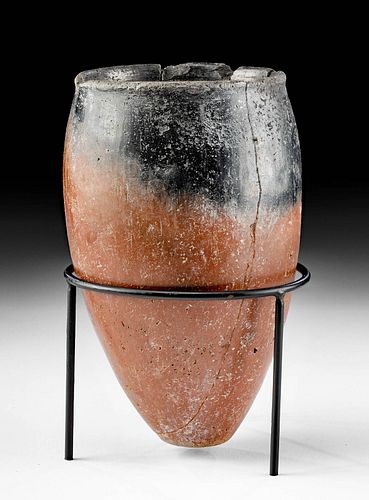Egyptian Predynastic Blacktop Pottery Jar, ex Petrie
Lot 9
About Seller
Artemis Fine Arts
686 S Taylor Ave, Ste 106
Louisville, CO 80027
United States
Selling antiquities, ancient and ethnographic art online since 1993, Artemis Gallery specializes in Classical Antiquities (Egyptian, Greek, Roman, Near Eastern), Asian, Pre-Columbian, African / Tribal / Oceanographic art. Our extensive inventory includes pottery, stone, metal, wood, glass and textil...Read more
Categories
Estimate:
$4,000 - $6,000
Absentee vs Live bid
Two ways to bid:
- Leave a max absentee bid and the platform will bid on your behalf up to your maximum bid during the live auction.
- Bid live during the auction and your bids will be submitted real-time to the auctioneer.
Bid Increments
| Price | Bid Increment |
|---|---|
| $0 | $25 |
| $300 | $50 |
| $1,000 | $100 |
| $2,000 | $250 |
| $5,000 | $500 |
| $10,000 | $1,000 |
| $20,000 | $2,500 |
| $50,000 | $5,000 |
| $100,000 | $10,000 |
| $200,000 | $20,000 |
About Auction
By Artemis Fine Arts
Dec 2, 2021
Set Reminder
2021-12-02 10:00:00
2021-12-02 10:00:00
America/New_York
Bidsquare
Bidsquare : Fine Antiquities | Asian | Ethnographic Art
https://www.bidsquare.com/auctions/artemis-gallery/fine-antiquities-asian-ethnographic-art-7918
Features classical antiquities, ancient and ethnographic art from cultures encompassing the globe. Egyptian, Greek, Roman, Etruscan, Near Eastern, Asian, Pre-Columbian, Native American, African / Tribal, Oceanic, Spanish Colonial, Russian, Fine / Visual Arts, so much more! Artemis Fine Arts info@artemisgallery.com
Features classical antiquities, ancient and ethnographic art from cultures encompassing the globe. Egyptian, Greek, Roman, Etruscan, Near Eastern, Asian, Pre-Columbian, Native American, African / Tribal, Oceanic, Spanish Colonial, Russian, Fine / Visual Arts, so much more! Artemis Fine Arts info@artemisgallery.com
- Lot Description
Ancient Egypt, Predynastic Period, early Naqada II, ca. 3500 to 3400 BCE. A beautiful coil-formed redware pottery jar exhibiting an inverted piriform body with a flat base, a carinated midsection that tapers for form the sloped shoulder, and a thin, gently lipped rim surrounding the cavernous basin. The upper black-hued portion of the rim is comprised of thick carbon deposits formed by administering the top to thick clouds of smoke for extended periods of time in an oxygen-deprived environment. Black-topped vessels originally rose to popularity during the early Naqada I, a culture which inhabited ancient Egypt during its pre-dynastic period. The Naqada were first described by famed archaeologist William Flinders Petrie; however, relatively little is known about them except that they were focused around the site of El-Amra in central Egypt, west of the Nile River. Size: 3.5" in diameter x 5.75" H (8.9 cm x 14.6 cm); 6" H (15.2 cm) on included custom stand.
Pre-Dynastic Egyptian black-top vessels were traditionally made from silt deposits taken from the Nile River due to their abundance in iron and silica. After the pot had dried but before it was fired, it would first be burnished and rubbed smooth with a small stone to create the pinstripe vertical striations still visible today. An iron-rich slip would then be applied just before firing; when placed in an oxygen-rich environment, the elevated temperatures would create the vessels' signature red-orange hue.
The label on the interior of this vessel indicates that it was found in 1895 by the famous Egyptologist Sir William Flinders Petrie (1853 to 1942) in Grave 277 at Naqada, Egypt and fits the form of blacktop vessel 57b from plate XX in "Naqada and Ballas. 1895." (William Flinders Petrie and J.E. Quibell, London: Bernard Quaritch, 1896). Its finding at grave 277 is further signified by the inscription of "277" on the base. The piece also appears in a list of contents of Naqada grave 277 in "Petrie's Naqada Excavation: a supplement" by Elise Baumgartel (London, 1970: pl. XII).
This piece has been searched against the Art Loss Register database and has been cleared. The Art Loss Register maintains the world's largest database of stolen art, collectibles, and antiques.
Provenance: private Corpus Christi, Texas, USA estate collection, acquired 1960s to 1970s; ex-private Oxford, UK collection; found by Sir William Flinders Petrie in Grave 277, Naqada, Egypt in 1895
All items legal to buy/sell under U.S. Statute covering cultural patrimony Code 2600, CHAPTER 14, and are guaranteed to be as described or your money back.
A Certificate of Authenticity will accompany all winning bids.
PLEASE NOTE: Due to recent increases of shipments being seized by Australian & German customs (even for items with pre-UNESCO provenance), we will no longer ship most antiquities and ancient Chinese art to Australia & Germany. For categories of items that are acceptable to ship to Australia or Germany, please contact us directly or work with your local customs brokerage firm.
Display stands not described as included/custom in the item description are for photography purposes only and will not be included with the item upon shipping.
#165348Collection label on interior and inscription on base. Repaired from at least 6 pieces with light restoration in areas, but most break lines visible. Minor perforation on side. Some losses to rim. Otherwise, very nice with lovely earthen deposits on interior.Condition
- Shipping Info
-
All shipping is handled in-house for your convenience. Your invoice from Artemis Gallery will include shipping calculation instructions. If in doubt, please inquire BEFORE bidding for estimated shipping costs for individual items.
-
- Buyer's Premium



 EUR
EUR CAD
CAD AUD
AUD GBP
GBP MXN
MXN HKD
HKD CNY
CNY MYR
MYR SEK
SEK SGD
SGD CHF
CHF THB
THB















